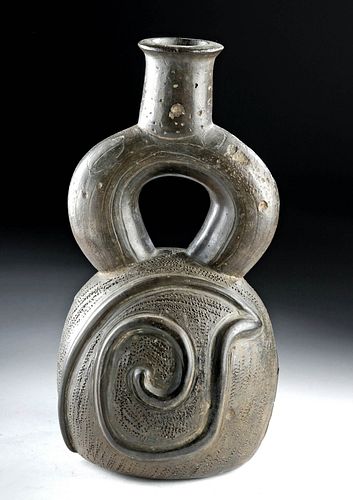Chavin Pottery Stirrup Vessel
Lot 113d
About Seller
Artemis Gallery
686 S Taylor Ave, Ste 106
Louisville, CO 80027
United States
Selling antiquities, ancient and ethnographic art online since 1993, Artemis Gallery specializes in Classical Antiquities (Egyptian, Greek, Roman, Near Eastern), Asian, Pre-Columbian, African / Tribal / Oceanographic art. Our extensive inventory includes pottery, stone, metal, wood, glass and textil...Read more
Estimate:
$1,700 - $2,550
Absentee vs Live bid
Two ways to bid:
- Leave a max absentee bid and the platform will bid on your behalf up to your maximum bid during the live auction.
- Bid live during the auction and your bids will be submitted real-time to the auctioneer.
Bid Increments
| Price | Bid Increment |
|---|---|
| $0 | $25 |
| $300 | $50 |
| $1,000 | $100 |
| $2,000 | $250 |
| $5,000 | $500 |
| $10,000 | $1,000 |
| $20,000 | $2,500 |
| $50,000 | $5,000 |
| $100,000 | $10,000 |
| $200,000 | $20,000 |
About Auction
By Artemis Gallery
Oct 8, 2020
Set Reminder
2020-10-08 10:00:00
2020-10-08 10:00:00
America/New_York
Bidsquare
Bidsquare : Exceptional Antiquities, Asian, Ethnographic
https://www.bidsquare.com/auctions/artemis-gallery/exceptional-antiquities-asian-ethnographic-5796
Museum-worthy examples of Egyptian, Greek, Roman, Etruscan, Near Eastern, Far East / Asian, Pre-Columbian, African / Tribal,Oceanic, Native American, Spanish Colonial, Russian, Fossils, Ancient Jewelry, Fine Art, so much more! Artemis Gallery info@artemisgallery.com
Museum-worthy examples of Egyptian, Greek, Roman, Etruscan, Near Eastern, Far East / Asian, Pre-Columbian, African / Tribal,Oceanic, Native American, Spanish Colonial, Russian, Fossils, Ancient Jewelry, Fine Art, so much more! Artemis Gallery info@artemisgallery.com
- Lot Description
Pre-Columbian, North Coast Peru, Casa Grande, earliest type of stirrup vessel called "Classic Chavin", ca. 1200 BCE. A stupendous example of the early monochrome stirrup vessels found in the mountains and river valleys of Northern Peru. Typical are the large spouts with arched forms, and stone polished surfaces. This beautiful vessel depicts spiraled tendrils of phytomorphic forms in bas relief with a textured ground. A stunning example with a carefully polished surface. Size: 10" H (25.4 cm)
The stirrup vessel form is named for the stirrup for horseback riding. In addition to being iconographically rich, these vessels were also practical. Their narrow openings prevented rapid evaporation of the precious liquid within - a great advantage given the extremely dry deserts of Peru. Note also that the shape of the neck made it easy to carry. Two stirrup vessels could be tied to the ends of a cord and suspended over a llama's back or a person's shoulder.
The Chavin civilization is generally regarded as the Andean mother civilization - oftentimes compared to the Olmec of Mexico. Both the Chavin and the Olmec cultures created the earliest Pre-Columbian visual culture that continued to flourish until European contact in the 16th century. Using molds and modeling the forms by hand, the Chavin made numerous stirrup-spout vessels like this example. Scholars have suggested that the indigenous used them to store fermented corn beer or "chicha".
Provenance: ex-Martha Lyman estate collection, Dayton, Tennessee, USA before 1990
All items legal to buy/sell under U.S. Statute covering cultural patrimony Code 2600, CHAPTER 14, and are guaranteed to be as described or your money back.
A Certificate of Authenticity will accompany all winning bids.
We ship worldwide and handle all shipping in-house for your convenience.
#146772Expected surface wear with nicks and abrasions to stirrup and spout. Patched probe holes on the stirrup. Chip to relief design on one side. Otherwise very good.Condition
- Shipping Info
-
All shipping is handled in-house for your convenience. Your invoice from Artemis Gallery will include shipping calculation instructions. If in doubt, please inquire BEFORE bidding for estimated shipping costs for individual items.
-
- Buyer's Premium



 EUR
EUR CAD
CAD AUD
AUD GBP
GBP MXN
MXN HKD
HKD CNY
CNY MYR
MYR SEK
SEK SGD
SGD CHF
CHF THB
THB
















